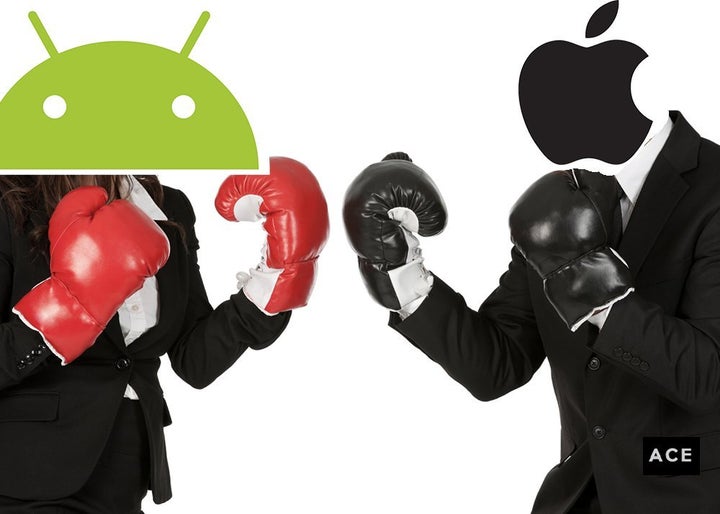
It’s a great time to break free from the tyranny of your mobile operating system. But which one?
For Seshu Kiran, it meant defecting to the popular Android operating system from Apple’s iOS. But Mark Beales went the other way.
It’s a little confusing, but then again, we live in confusing times. Before we get to the reasons that Kiran and Beales bailed on their platforms, let’s pause for a minute to look at the mobile OS landscape.
By “mobile OS” I mean the software that runs on your mobile phone or tablet. Apple’s iOS held a 33 percent market share for last year, while Google’s Android operating system claimed a commanding 59 percent share, according to Net Market Share. The year before, it was more competitive: 44 percent to Apple and 46 percent to Google.
There’s a reason for the retreat of iOS, as others have found out. But to understand why, let’s get back to Kiran, an engineer from Los Angeles who dumped his iPhone for an Android phone recently.
Kiran, once a loyal iPhone user, says he felt continuous pressure to upgrade to the latest device. He became more uncomfortable with it as time went on, leading up to the latest iPhone, which removed the headphone jack.
“I heard someone in Europe was using a washing machine for 35 years without any trouble,” he says. “Think of your favorite smartphone manufacturer venturing into home appliances. It would be a disaster for customers, and it is already happening in the name of ‘smart’ slapped on to any simple device.”
What led him to the breaking point? An upgrade of his iPhone that “killed” the device. That’s a common complaint, and it’s something I’ve personally experienced. One day your iPhone photos are crisp and beautiful, but then, after what seems like a routine system upgrade, they’re all blurry. Hmm, maybe it’s time for a new phone?
“The choice of Android came as a natural resistance for Apple demanding me to buy a new phone,” he says. “When was the last time a blender needed an unsolicited purchase in the pretext of a certain upgrade?”
For Beales, a retired mortgage banker, the move from Android to iOS was prompted by a “must have” feature: FaceTime, the popular video telephony application.
“We saw how well FaceTime worked for our kids and friends, as well as seeing the greatly improved camera capability, so both my wife and I switched to Apple’s iPhone,” he says. “The convenience of being able to link up with our grandchildren using FaceTime can not be matched by any other service.”
(Interestingly, Google is trying to match the FaceTime experience with a new app called Duo. You can call a FaceTime user, too.)
But his experience underscores the main reason users would want to discard their Android phone: iOS, for all its faults, remains a slicker, more intuitive interface.
Leaving iOS
In principle, leaving one mobile OS for another is relatively easy. The iOS to Android transfer is dead simple, handled in three easy steps that primarily involve moving most of your data to the cloud. The Android-to-iOS switch is a little more complicated ― it involves seven steps that include uploading, downloading and adding codes to your new phone ― but still, not terribly difficult.
But in practice, the switch can be more problematic. I learned that myself when I switched systems recently. Like Kiran, I’d grown tired of Apple’s high-pressure upgrades and was unimpressed with the new crop of iPhones. Removing the headphone jack from the iPhone 7 was a step too far. I knew the tiny wireless headsets, called AirPods, wouldn’t last 24 hours in my house. I have cats that play with everything.
As an early adopter of Gmail and Google Docs, transferring my data wasn’t a problem ― it was already in the cloud.
Even though I upgraded from an iPhone 6 to perhaps the best Android phone on the market, the new Google Pixel, I had some difficulty adjusting to the new operating system’s look and feel. I was one of the Apple enthusiasts who lined up for the the first iPhone in 2007. This felt almost like a betrayal. And yet I knew It was time to move on.
Setting up the new phone was mostly easy, with a few painful moments. I lost nearly all the Google Voice functionality (Voice is Google’s cloud-based calling application) when I decided to drop my old cell phone number in favor of my Google Voice number. That’s a migration quirk that will hopefully be fixed soon.
I also struggled to learn where everything was in Android. System settings, phone options and apps are all handled slightly differently than on iOS. It’s a little bit like learning a new dialect of your mother tongue. It’s the same, but different.
Although my Android phone is now my primary phone, I find myself turning to my old iPhone to catch up on news or send a message. I suspect I’ll never completely leave the Apple fold ― I still use a MacBook Pro for my writing ― but it feels good to have more options and to have a little fluency in Android. Also, I won’t feel compelled to buy the next iPhone when it’s released later this year. No sir, no more 24-month upgrade cycle for me ― I hope.
Wherever you go, there you are
Maybe Buckaroo Banzai, the video game hero, had it right, when it comes to phone operating systems. Wherever you go, there you are. And I’m not alone. David Radin, a former technology columnist for the Pittsburgh Post-Gazette who now runs a scheduling app company, says his family is evenly split between iOS and Android.
“When we upgrade, we consider the switch,” he says, “and almost never decide to change in either direction.”
That’s because both operating systems are really about the same, when it comes right down to it. They each have their strengths and weaknesses, but in the end, it kind of all evens out. In the end, the choice about leaving or staying may depend on what you want from the mobile OS.
For example, Radin’s daughter, who also uses a Pixel, likes the seamless integration with Google Photos, Google’s cloud-based storage. When you take a picture with your Android phone, it can automatically upload the image to the cloud and store it there in full resolution.
“That’s something that iCloud ― Apple’s cloud-based storage system ― doesn’t do,” he says.
No kidding. I pay extra to store my photos on iCloud, and it still doesn’t accommodate all of them.
Long term, the solution to this mobile OS conundrum may be similar, if not identical, to the one plaguing the computer operating system ― moving to a more open-source platform that runs on any device and works with any wireless network. It’s something that could have been built years ago, if there had been any money in it.
OS developers know it’s the right direction, but they also know it won’t be profitable.
“As long as Apple is at the forefront of smartphone tech then a fully open source OS environment is a long way off,” says Brandon Ackroyd, the head of customer insight for Tiger Mobiles, a UK-based phone comparison site. “Apple understands the value of owning the whole smartphone experience from hardware to software, I can’t see them giving it up. Even Google is realizing the value in having their own devices with the Pixel phones, they know if they do the software and the hardware the overall user experience is so much better.”
Maybe that’s why open-source mobile OS efforts such as Moblin, Maemo, MeeGo, Sailfish and Tizen have all flopped. But there’s still time. We’re only a decade into the smartphone revolution, and there are probably years to go before another disruptive technology comes along to displace it.
Until then, switching mobile OSs will feel a lot like trading one prison for another. It may appear like you’ve broken free, but you’re just on a different cell.
Christopher Elliott specializes in solving seemingly unsolvable consumer problems. Contact him with your questions on his advocacy website. You can also follow him on Twitter, Facebook and Google or sign up for his newsletter.
